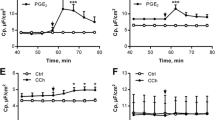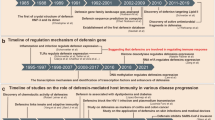Abstract
The human β-defensin-2 (hBD-2) is expressed in epithelial cells of skin and respiratory and gastrointestinal tracts. Defensins are arginine-rich small cationic peptides with six intramolecular disulfide bonds and are antimicrobially active against a broad spectrum of pathogens. In addition, they have cytokine-like immunomodulatory properties. We hypothesized that hBD-2 also might influence epithelial cells themselves, thereby altering fluid composition in the gastrointestinal tract. We therefore tested its impact on electrogenic ion transport properties of distal colon in Ussing chamber experiments. Application of hBD-2 did not affect transepithelial voltage or resistance in cAMP-stimulated distal colon. However, it increased cholinergic Ca2+-dependent Cl− secretion. After 20 min of incubation with hBD-2, the effect of carbachol (CCh) on the equivalent short circuit current (I′sc) was enhanced twofold compared to vehicle-treated colon. Modulation of Ca2+ signaling by hBD-2 was validated by Fura-2 measurements in human colon carcinoma HT29 cells. Twenty-minute incubation with hBD-2 increased the CCh-induced Ca2+ transient by 20–30% compared to either vehicle-treated cells or cells treated with the defensins hBD-1, hBD-3, or HD-5. This effect was concentration-dependent, with an EC50 of 0.043 µg/ml, and still present in the absence of extracellular Ca2+. Also, the ionomycin-induced Ca2+ transient was increased by hBD-2 treatment. We conclude that hBD-2 facilitates cholinergic Ca2+-regulated epithelial Cl− secretion. These findings contribute to the concept of a specific interaction of antimicrobial peptides with epithelial function.






Similar content being viewed by others
References
Ballard ST, Spadafora D (2007) Fluid secretion by submucosal glands of the tracheobronchial airways. Respir Physiol Neurobiol 159:271–277
Bals R, Wang X, Meegalla RL, Wattler S, Weiner DJ, Nehls MC, Wilson JM (1999) Mouse beta-defensin 3 is an inducible antimicrobial peptide expressed in the epithelia of multiple organs. Infect Immun 67:3542–3547
Bals R, Wang X, Wu Z, Freeman T, Bafna V, Zasloff M, Wilson JM (1998) Human beta-defensin 2 is a salt-sensitive peptide antibiotic expressed in human lung. J Clin Invest 102:874–880
Biragyn A, Ruffini PA, Leifer CA, Klyushnenkova E, Shakhov A, Chertov O, Shirakawa AK, Farber JM, Segal DM, Oppenheim JJ, Kwak LW (2002) Toll-like receptor 4-dependent activation of dendritic cells by beta-defensin 2 1. Science 298:1025–1029
Bleich M, Ecke D, Schwartz B, Fraser G, Greger R (1997) Effects of the carcinogen dimethylhydrazine (DMH) on the function of rat colonic crypts. Pflugers Arch 433:254–259
Drin G, Scarlata S (2007) Stimulation of phospholipase Cbeta by membrane interactions interdomain movement, and G protein binding—how many ways can you activate an enzyme? Cell Signal 19:1383–1392
Ecke D, Bleich M, Schwartz B, Fraser G, Greger R (1996) The ion conductances of colonic crypts from dexamethasone-treated rats. Pflugers Arch 431:419–426
Field M (2003) Intestinal ion transport and the pathophysiology of diarrhea. J Clin Invest 111:931–943
Ganz T (2003) Defensins: antimicrobial peptides of innate immunity 2. Nat Rev Immunol 3:710–720
Goldman MJ, Anderson GM, Stolzenberg ED, Kari UP, Zasloff M, Wilson JM (1997) Human beta-defensin-1 is a salt-sensitive antibiotic in lung that is inactivated in cystic fibrosis. Cell 88:553–560
Greger R, Allert N, Frobe U, Normann C (1993) Increase in cytosolic Ca2+ regulates exocytosis and Cl− conductance in HT29 cells. Pflugers Arch 424:329–334
Harder J, Bartels J, Christophers E, Schroder JM (1997) A peptide antibiotic from human skin. Nature 387:861
Harder J, Bartels J, Christophers E, Schroder JM (2001) Isolation and characterization of human beta-defensin-3, a novel human inducible peptide antibiotic. J Biol Chem 276:5707–5713
Kagan BL, Selsted ME, Ganz T, Lehrer RI (1990) Antimicrobial defensin peptides form voltage-dependent ion-permeable channels in planar lipid bilayer membranes. Proc Natl Acad Sci USA 87:210–214
Kerst G, Fischer KG, Normann C, Kramer A, Leipziger J, Greger R (1995) Ca2+ influx induced by store release and cytosolic Ca2+ chelation in Ht29 colonic carcinoma cells. Pflugers Arch 430:653–665
Kourie JI, Shorthouse AA (2000) Properties of cytotoxic peptide-formed ion channels. Am J Physiol Cell Physiol 278:C1063–C1087
Krause KH, Fivaz M, Monod A, van der Goot FG (1998) Aerolysin induces G-protein activation and Ca2+ release from intracellular stores in human granulocytes. J Biol Chem 273:18122–18129
Kunzelmann K, Mall M (2002) Electrolyte transport in the mammalian colon: mechanisms and implications for disease. Physiol Rev 82:245–289
Kunzelmann K, Schreiber R, Boucherot A (2001) Mechanisms of the inhibition of epithelial Na(+) channels by CFTR and purinergic stimulation. Kidney Int 60:455–461
Leipziger J, Fischer KG, Greger R (1994) Voltage-dependent Ca2+ influx in the epithelial cell line HT29: simultaneous use of intracellular Ca2+ measurements and nystatin perforated patch-clamp technique. Pflugers Arch 426:427–432
Lencer WI, Cheung G, Strohmeier GR, Currie MG, Ouellette AJ, Selsted ME, Madara JL (1997) Induction of epithelial chloride secretion by channel-forming cryptdins 2 and 3. Proc Natl Acad Sci USA 94:8585–8589
Mall M, Bleich M, Schurlein M, Kuhr J, Seydewitz HH, Brandis M, Greger R, Kunzelmann K (1998) Cholinergic ion secretion in human colon requires coactivation by cAMP. Am J Physiol 275:G1274–G1281
Matthews JB (2002) Molecular regulation of Na+-K+-2Cl− cotransporter (NKCC1) and epithelial chloride secretion. World J Surg 26:826–830
Merlin D, Yue G, Lencer WI, Selsted ME, Madara JL (2001) Cryptdin-3 induces novel apical conductance(s) in Cl− secretory, including cystic fibrosis, epithelia. Am J Physiol Cell Physiol 280:C296–C302
Morgera F, Antcheva N, Pacor S, Quaroni L, Berti F, Vaccari L, Tossi A (2008) Structuring and interactions of human beta-defensins 2 and 3 with model membranes. J Pept Sci 14:518–523
Morrison GM, Semple CA, Kilanowski FM, Hill RE, Dorin JR (2003) Signal sequence conservation and mature peptide divergence within subgroups of the murine beta-defensin gene family. Mol Biol Evol 20:460–470
Nitschke R, Benning N, Ricken S, Leipziger J, Fischer KG, Greger R (1997) Effect of intracellular pH on agonist-induced [Ca2+]i transients in HT29 cells. Pflugers Arch 434:466–474
Nitschke R, Leipziger J, Greger R (1993) Agonist-induced intracellular Ca2+ transients in HT29 cells. Pflugers Arch 423:519–526
O’Neil DA (2003) Regulation of expression of beta-defensins: endogenous enteric peptide antibiotics. Mol Immunol 40:445–450
O’Neil DA, Porter EM, Elewaut D, Anderson GM, Eckmann L, Ganz T, Kagnoff MF (1999) Expression and regulation of the human beta-defensins hBD-1 and hBD-2 in intestinal epithelium. J Immunol 163:6718–6724
Patil AA, Cai Y, Sang Y, Blecha F, Zhang G (2005) Cross-species analysis of the mammalian beta-defensin gene family: presence of syntenic gene clusters and preferential expression in the male reproductive tract. Physiol Genomics 23:5–17
Sahly H, Schubert S, Harder J, Rautenberg P, Ullmann U, Schroder J, Podschun R (2003) Burkholderia is highly resistant to human beta-defensin 3. Antimicrob Agents Chemother 47:1739–1741
Salzman NH, Underwood MA, Bevins CL (2007) Paneth cells, defensins, and the commensal microbiota: a hypothesis on intimate interplay at the intestinal mucosa. Semin Immunol 19:70–83
Selsted ME, Ouellette AJ (2005) Mammalian defensins in the antimicrobial immune response. Nat Immunol 6:551–557
Semple CA, Rolfe M, Dorin JR (2003) Duplication and selection in the evolution of primate beta-defensin genes. Genome Biol 4:R31
Sorensen OE, Borregaard N, Cole AM (2008) Antimicrobial peptides in innate immune responses. Contrib Microbiol 15:61–77
Suresh A, Verma C (2006) Modelling study of dimerization in mammalian defensins. BMC Bioinformatics 7(Suppl 5):S17
Tieleman DP, Shrivastava IH, Ulmschneider MR, Sansom MS (2001) Proline-induced hinges in transmembrane helices: possible roles in ion channel gating. Proteins 44:63–72
Turner JR (2006) Molecular basis of epithelial barrier regulation: from basic mechanisms to clinical application. Am J Pathol 169:1901–1909
Warth R, Bleich M (2000) K+ channels and colonic function. Rev Physiol Biochem Pharmacol 140:1–62
Yang D, Biragyn A, Kwak LW, Oppenheim JJ (2002) Mammalian defensins in immunity: more than just microbicidal. Trends Immunol 23:291–296
Yang D, Chertov O, Bykovskaia SN, Chen Q, Buffo MJ, Shogan J, Anderson M, Schroder JM, Wang JM, Howard OM, Oppenheim JJ (1999) Beta-defensins: linking innate and adaptive immunity through dendritic and T cell CCR6. Science 286:525–528
Yue G, Merlin D, Selsted ME, Lencer WI, Madara JL, Eaton DC (2002) Cryptdin 3 forms anion selective channels in cytoplasmic membranes of human embryonic kidney cells. Am J Physiol Gastrointest Liver Physiol 282:G757–G765
Zasloff M (2002) Antimicrobial peptides of multicellular organisms. Nature 415:389–395
Acknowledgments
We thank the department of animal care of the Christian-Albrechts-Universität Kiel (CAU) for their excellent support in breeding and animal handling. We thank T. Stegmann and J. Brdon for technical assistance. This work was supported by CAU grants to M.B. and by SFB617.
Author information
Authors and Affiliations
Corresponding author
Rights and permissions
About this article
Cite this article
Himmerkus, N., Vassen, V., Sievers, B. et al. Human β-defensin-2 increases cholinergic response in colon epithelium. Pflugers Arch - Eur J Physiol 460, 177–186 (2010). https://doi.org/10.1007/s00424-009-0780-x
Received:
Revised:
Accepted:
Published:
Issue Date:
DOI: https://doi.org/10.1007/s00424-009-0780-x




